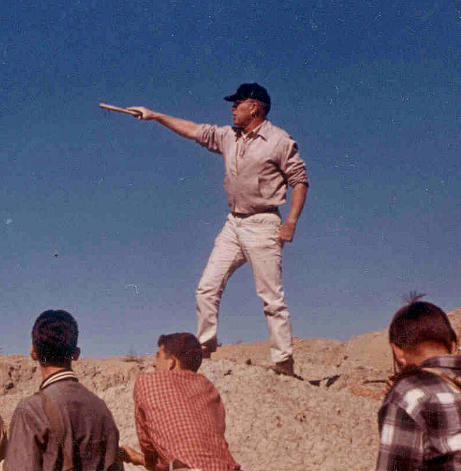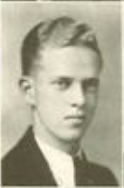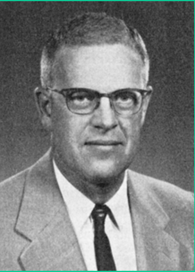Breadcrumb
- Home
- About
- Iowa Geode Stars
- Bill Furnish
Bill Furnish (1912-2007)

William Madison Furnish, Jr, known to colleagues and students as Bill, was a classical naturalist who channeled his career and life through many aspects of geology. Like many 18th and 19th century founders of the science of geology, Furnish explored the world through scientific observations of flora and fauna in extant and fossilized forms. His education and life, professional and personal, was rooted in Iowa, where he applied keen and thorough observations of the world around him to understanding and interpreting global phenomena. His curiosity and work carried him far from his Iowa roots to locations throughout North America from New Jersey to Texas, Arctic Canada to Russia, and notably Saudi Arabia and Venezuela. His interpretations of the Earth’s history arose from this broad geographic and temporal knowledge of life in various forms preserved in sedimentary rocks of the world.
He was born on August 17, 1912 in Tipton, Iowa to William Madison Furnish and Jean Minto Swartzlender. He graduated from Tipton High School and started his post-secondary academics at Tipton Junior College. Ultimately, he transferred to the State University of Iowa, where he earned a Liberal Arts BA in 1934. During this year, the University underwent an historic change in the presidency providing the names for new campus buildings that were starting to fill the expanded campus area. Walter Jessup, State University of Iowa President, resigned to become president of the Carnegie Foundation for the Advancement of Teaching, handing the reins of the University to Dean of the College of Law, Eugene Gilmore. Furnish studied and taught within Jessup’s newly formed College of Letters, and conducted his paleontological research.

While an undergraduate at the University of Iowa, Furnish met A.K. Miller who became a lifelong colleague. Under Miller’s mentorship, he earned a MS in 1935 and a PhD in 1938, both advanced degrees in Geology. As a graduate student, he was the first to extract conodonts from limestone using acetic acid, a process that became the conventional technique. His dissertation topic, “Conodonts from the Prairie du Chien [Lower Ordovician] Beds of the Upper Mississippi Valley,” characterized conodonts from Iowa, Minnesota, and Wisconsin. The publication of his dissertation represented one of two major advances in the study of Ordovician conodonts since the first monograph describing conodonts by Pander in 1856. Furnish’s work became the basis for a tradition of conodont research at Iowa. This work also established Bill as a pioneer in the field of conodont biostratigraphy, which became a critical element in worldwide correlation of rock units.
In the same year he received his Ph.D., Furnish married Eula Berniece Beck (Becky). Becky was also a student at the State University of Iowa where she earned a BA in Sociology in 1937. Bill and Becky met in Calvin Hall, the classic brick building that housed the Geology Department until 1974. Here, she worked in the Geology Library while a student providing an additional reason for William to visit other than journal articles and fossil descriptions.
Furnish launched his post-doctoral career at Iowa during 1939 and 1940 as a Research Assistant in Geology with his familiar mentor, Professor A.K. Miller. During this time he extended his paleontological interests to molluscs, particularly nautiloids and ammonoids, while describing and publishing research on their occurrence in sediments found in the Guadalupe Mts of West Texas as well as sites in Mexico, Venezuela, Trinidad, and Panama.
In 1940, he left Iowa to teach geology at Oklahoma State University in Stillwater. While in Oklahoma he expanded the geography of his research interests to include Permian Cephalopods in Chiapas, Mexico. His teaching and publication interests took a hiatus during World War II years when he worked as a petroleum geologist in Texas and Louisiana. This experience opened opportunities to continue work as a petroleum geologist in Maracaibo, Venezuela with Creole (Standard of New Jersey), then Aramco in Dhahran, Saudi Arabia from 1949 to 1953. Furnish dramatically expanded known oil reserves in both countries laying claim to selecting sites for 80 percent of wells currently in production in Saudi Arabia. Long weeks in the desert and the need to send his eldest child to distant boarding schools convinced the family to return to Iowa and resume work with A. K. Miller.

In 1953, Furnish returned to the University of Iowa where he became a Full Professor in 1956 and ultimately chair of the department shortly after. Here he taught Introductory Geology, Stratigraphy, and Petroleum Geology. His lectures to undergraduates were especially notable in their ability to entrance students through personal anecdotes, highly effective stories, and sound practical understanding of basic principles of geology and paleontology.
During his 25-year tenure at Iowa he was a popular mentor for graduate students and he was sought out to serve on theses and dissertation committees because of his broad experience and strong interest in field geology. He often provided insight into the distribution of plant communities as clues to underlying rock types and structural features. He was famous for requiring PhD candidates to understand the regional geologic and natural resource context of their research by asking probing questions on their preliminary qualifying examinations. His universal esteem among graduate students was, in part, a result of his treating them as colleagues, with high expectations causing them to function accordingly to meet those expectations.
Furnish directed Iowa’s geology summer camps for many years in the Black Hills and Bighorns, often accompanied by his family. Fish and birds often ended up on the dinner table, yielding to fly rod or ever-present Beretta 22 on his hip. He spent many years exploring the Big Horn Mountains and much of the western US with undergraduate and graduate students. These summer expeditions were magnets that attracted students and provided lessons for his family as well. Sleeping under the stars, living off the land, and engaging the diminishing frontier life were passions he shared with students of all ages. His enduring image is at the wheel of his beloved 4WD ‘57 Willys pickup, sweat-stained Stetson, khaki shirt with rolled up sleeves, walking stick close at hand, amid dust and ubiquitous sagebrush, always looking for adventure.
The largest volume of his research products focused on invertebrate paleontology, particularly cephalopods. He regularly published descriptions of cephalopod assemblages and the ecology of their occurrence through the sediments in which their fossil remains were found. However, his greatest impact on stratigraphy, paleontology, and paleoecology remains his work on conodonts. Furnish was a pioneer in developing classification systems for these enigmatic fossils to allow them to be used as biostratigraphic markers. The systems he developed led to their use in correlating rock units throughout the world.
Furnish was a member of Sigma Xi, scientific fraternity, at the University of Iowa. He was editor of the Journal of Paleontology from 1955 to 1957, served as president of the Society of Economic Paleontologists and Mineralogists 1960-1961, and became an honorary member in 1974 In 1938, Furnish’s first encounter with conodonts was his credit for describing the genus Acanthodus from the Prairie du Chien (Lower Ordovician) beds of the upper Mississippi valley. In 1964 he and Carl B. Rexroad, were credited for describing the genus Hindeodus from the Pella Formation (Mississippian) of South- Central Iowa. He was a well-recognized conodont expert and in 1977 was awarded the Medal of the Pander Society. The conodont genus Furnishina, Müller 1959, is a tribute to Professor Furnish’s importance in the field of conodont paleontology. In addition to his research excellence, Furnish was a beloved and respected teacher and received the National Association of Geology Teachers' Award in 1985.
Furnish’s retirement in 1978 left a large gap in the academic resources offered by the University. Fortunately, he and Becky redirected their community contributions through their 120-acre property surrounding a former quarry on the Cedar River near the famous Rochester Cemetery prairie. From the home they built on this property, the Furnishes provided an outdoor playground for their family and a natural laboratory for anyone interested in visiting. Furnish also gave much back to his local community and the State of Iowa through public boards of conservation and natural resources. He served on the Cedar County Historical Society, formed to preserve the historical background and record the current history of Cedar County. His work for the Society attracted the attention of the Governor, who appointed Furnish to the Iowa Advisory Board for Preserves. In 1983, he helped oversee the merger of Iowa’s lands, waters, forestry, fish and game agencies into the Department of Water, Air, and Waste Management. His service evolved to that of a member of the Iowa Conservation Commission at this critical juncture in the history of Iowa’s natural resource management. This commission oversees the Division of Conservation and Recreation Services that, along with the Environmental Protection Commission is now the Iowa Department of Natural Resources.
In addition to his career and public service, Furnish enjoyed a rich personal life. He and Becky had five children: Dale, Ann, Jean, James, and Joseph. They lived in their Cedar River house for 25 years and enjoyed having their 16 grandchildren visit them. After retirement William pursued his passion for double-barrel shotguns and became a legendary collector and advocate (after collecting barbed wire failed to engage his interest). He donated his shotgun collection to the Cody Firearms Museum in WY. In 1999, the Furnishes moved back to Iowa City where they lived in the Oaknoll Retirement Residence.
Eula Berniece Beck passed away on January 7, 2005. William Madison Furnish died on November 9, 2007.
Sample of Publications
Eight decades of publications evidence a remarkable research career! His collaboration with his mentor and students is evidenced in a sample of the publication legacy of William Madison Furnish.
- Furnish, WM, Glenister, BF, Jürgen Kullmann, J, and Zhou, Z. 2009. Treatise on Invertebrate Paleontology, Part L (Revised): Mollusca, vol. 2. Carboniferous and Permian Ammonoidea, University of Kansas Paleontological Institute PA Selden (ed) 259p, 139 fig. 1 table. Dedicated to William Madison Furnish
- Furnish, WM, Glenister, BF, Kummel, B and pinosa, C. 1976. Reinterpretation of ceratitic ammonoids from the Greville Formation, New Zealand. Geol. Magazine. 113:1:39-46.
- Furnish, WM, Glenister, BF, Nakazawa, K, and Kapoor, HM. 1973. Permian Ammonoid Cyclolobus from the Zewan Formation, Guryul Ravine, Kashmir. Science. 180:4082:188-190.
- Furnish, WM, and Glenister, BF. 1964. Treatise on invertebrate paleontology, Part K, Mollusca. Geol. Soc. Amer.
- Furnish, WM, Glenister, BF, and Hansman, RH. 1962. Brachycycloceratidae, Novum, Deciduous Pennsylvanian Nautiloids. Jour. Paleo. 36:6:1341-1356.
- Furnish, WM. 1961. Role of a specialist. AAPG Bull: 45:7:1011–1013.
- Stone, GL and Furnish, WM. 1959. Bighorn Conodonts from Wyoming. Jour. Paleo. 33:2:211-228.
- Miller, AK, and Furnish, WM. 1940. Permian Ammonoids of the Guadalupe Mountain Region and Adjacent Areas. GSA Special Papers No. 26. 238p.
- Furnish, WM. 1938. Conodonts from the Prairie du Chien (Lower Ordovician) Beds of the Upper Mississippi Valley. Jour. Paleo: 12:4:318-340.
- Furnish, WM, Barragy, EJ, and Miller, AK. 1936. Ordovician Fossils From Upper Part of Type Section of Deadwood Formation, South Dakota. AAPG Bulletin 20:10:1329–1341.
This tribute was produced through a collaboration led by Mike Burkart and included Jim Furnish, Ann Furnish, Gil Klapper, and Dick Baker in 2020.